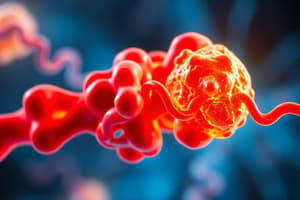Podcast
Questions and Answers
In a favorable process where ΔG is negative, what is the relationship between the actual concentrations of reactant and product at equilibrium?
In a favorable process where ΔG is negative, what is the relationship between the actual concentrations of reactant and product at equilibrium?
- The actual concentrations are greater than the equilibrium concentrations
- The actual concentrations are less than the equilibrium concentrations
- The actual concentrations are equal to the equilibrium concentrations (correct)
- The actual concentrations are not related to the equilibrium concentrations
If Keq = 1, what can be said about ΔGo?
If Keq = 1, what can be said about ΔGo?
- ΔGo < 0
- ΔGo cannot be determined from the given information
- ΔGo > 0
- ΔGo = 0 (correct)
According to the given equation, what can be concluded if Keq > 1?
According to the given equation, what can be concluded if Keq > 1?
- ΔGo cannot be determined from the given information
- ΔGo = 0
- ΔGo > 0
- ΔGo < 0 (correct)
What is the relationship between the standard free energy changes (ΔGo) of two consecutive reactions?
What is the relationship between the standard free energy changes (ΔGo) of two consecutive reactions?
What type of process is the coupling of a favorable process (–ΔG) with an unfavorable process (+ΔG) to yield an overall –ΔG?
What type of process is the coupling of a favorable process (–ΔG) with an unfavorable process (+ΔG) to yield an overall –ΔG?
Flashcards are hidden until you start studying



